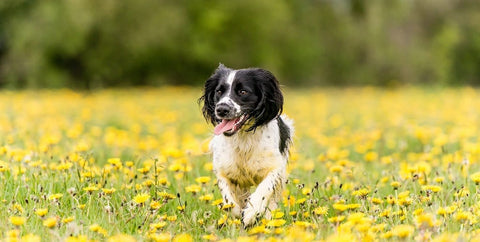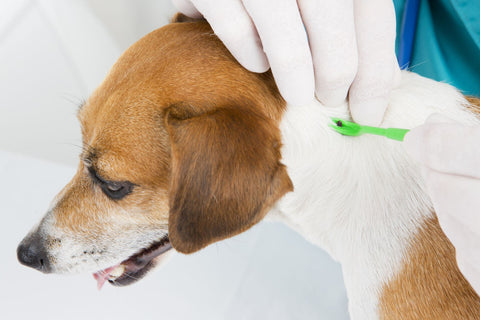

Environmental & seasonal allergies in dogs: Allergens, diagnosis & treatment
Scratching your head as to why your pup is scratching its skin? Environmental and seasonal allergies may be the culprit. A dog's immune system can overreact to harmless things like dust mites, moulds and pollens. When those triggers are only around at certain times of year, the result is seasonal allergies. Here’s what you need to know about signs, diagnosis, and treatment.
Environmental allergy problems in dogs
Environmental allergies aren’t just about the great outdoors, your home can be full of allergens too. An allergen is simply any substance (often a protein) that triggers an abnormal immune response. They aren’t harmful, but your dog’s body treats them as a threat.
As the immune system tries to capture and fight off allergens, it causes inflammation and itchiness. Some allergens are present year-round, while others, like pollens, peak seasonally.
Allergies often start young—6 months to 3 years—and rarely go away. In fact, symptoms often worsen over time. Here’s why:
- The immune system stays on high alert, ready to react.
- Scratching and licking damage the skin barrier, letting more allergens in.
- Long-term skin changes and secondary infections add to the vicious cycle.
If your dog’s itching gets worse at certain times of year, it may point to an environmental or seasonal cause rather than dog food allergies, but it’s rarely that simple.
Skin allergies in dogs
Skin allergies, also called allergic dermatitis, are just allergies that affect the skin. It’s a term that describes the symptoms, not the underlying cause. Triggers can include flea bites (flea allergy dermatitis), food allergens, or environmental allergens.
Common signs include:
- Redness and itching
- Licking, chewing, or rubbing
- Hair loss and increased shedding
- Inflamed ears
- Secondary infections (yeast infections often smell musty)
- Sensitive skin, irritability or even extreme relief when touched
- Restlessness if the itch is severe
- Long-term changes: thickened, grey, “elephant-like” skin
Seasonal allergies in dogs
Seasonal allergies are environmental allergies that flare up at certain times of year, often triggered by pollen. While your pup’s underlying sensitivity is constant, the symptoms worsen when allergen levels spike.
It’s a bit like hay fever in humans. Unlike people, though, dogs don’t often get sneezing, runny noses, or watery eyes. Instead, the main signs are skin-related, though allergic rhinitis or conjunctivitis can also occur.
Atopic dermatitis in dogs
Atopic dermatitis (atopy) is a type of allergic skin disease usually triggered by environmental allergens. It’s thought to result from genetics and a faulty skin barrier.
There’s no single test to confirm atopic dermatitis. But if your dog has environmental allergies and a family history of skin problems, your vet may use the term “atopy.”

Common environmental allergens for dogs
Year-round allergens include:
- Dust mites
- Storage mites
- Moulds
- Yeasts
Seasonal allergens, which peak at certain times of year, include:
- Grass pollens
- Tree pollens
- Weed pollens
How can I tell if my dog has environmental allergies?
If your dog’s symptoms flare up at certain times of year, that’s highly suspicious for a seasonal environmental allergy. However, dogs can (and often do) have more than one type of allergy at the same time, so seasonal patterns may not tell the full story.
Food allergies can cause very similar skin symptoms. While they can cause tummy upsets, they don’t always, so you can’t rely on digestive signs alone to tell the difference.
If you’re noticing red, itchy skin, hair loss, inflamed ears, or the other signs described earlier, then your dog may well have an allergy.
Diagnosing dog allergies
The first step in diagnosis is ruling out other causes of itching, such as fleas, mites and ringworm. Your vet may use skin scrapes, hair plucks, or other tests to look for parasites or infections.
If these are clear, your pup may well have allergies, and if they have 5 or more of the following signs, they may have atopic dermatitis:
- Ear flaps are affected, but not along the edges
- Front paws affected
- Symptoms starting before age 3
- Chronic or recurrent yeast infections
- Itchiness that responds to steroids
- Mostly indoor lifestyle
- No lesions on the lower back
- Itching that started before noticable skin changes
Allergies can’t be cured, so if your pup only has mild symptoms, treatment may focus only on controlling the itch and protecting the skin.
For more severe or persistent cases, additional testing may be recommended:
- Blood tests: depending on the test, these measure IgE antibodies to a range of environmental and food allergens, but don’t always give a definitive answer.
-
Intradermal skin testing: tiny amounts of allergens are injected into the skin to see which trigger a reaction.
These tests can help guide treatment decisions, including immunotherapy.

How to treat environmental, seasonal & skin allergies in dogs
Allergies rarely disappear and can’t be cured. Treatment is usually a case of chipping away at the itch by combining as many strategies as possible to soothe the skin and reduce self-trauma.
1. Reduce itching
- Steroids: effective but have well-known long-term side effects.
- Dog safe antihistamines: usually only mildly effective, best used alongside other measures.
-
Immune-modulating drugs: reduce the immune system’s overreaction, sometimes used long-term or during flare-ups. Read our guide to itchy skin in dogs.
2. Support skin health
- Supplements for skin and coat conditions
- Medicated shampoos to wash away allergens and strengthen the skin barrier—choose one based on your dog’s main symptoms (itchy, flaky, oily, dry).
-
Wipes, mousses, and sprays to maintain effects between baths (especially helpful for large dogs or those who hate bathing).
3. Allergen avoidance
- Hard to achieve, but can help:
o Walk during times of low pollen count (early morning or late evening).
o Limit rolling in grass if grass pollen is a trigger.
o Keep bedding and living spaces clean to reduce dust mites and mould.
4. Immunotherapy
- Specially formulated injections, given with tiny needles, to try and retrain the immune system.
The takeaway
Environmental and seasonal allergies are common in dogs and can range from a mild nuisance to intense itching. They can’t be cured, and management takes teamwork and a combination of strategies. The good news is that with patience and planning, symptoms are often manageable, meaning your pup can get back to enjoying life without being driven crazy by the itch.



